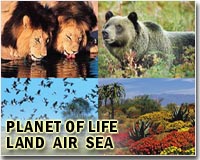| . |  |
. |
Shell Beach, Louisiana (AFP) May 2, 2010 There are few boats here today and Frank Campo has a feeling it will only get worse, that the giant oil slick in the Gulf of Mexico will soon lap into the bountiful marsh near his marina. "I'd hate to think that an oil spill killed me and the hurricane didn't," the 68-year-old Campo, whose century-old marina holds legendary status and was rebuilt after Hurricane Katrina destroyed it in 2005, said Sunday. The approaching oil slick poses a threat that residents of Louisiana's coastal areas have difficulty gauging, causing some to fear that it could lead to a lost generation of fishermen and others who make a living off the water. As some put it here, they know how to pick up a hammer and nails to rebuild after a storm. Cleaning and restoring the region's vitally important marshland if it becomes soaked in oil is another matter entirely. "We're going to get it. There's no doubt in my mind," said Ernie Alphonso, a 48-year-old fishing guide in nearby Delacroix, predicting a severe impact from the oil. "This is going to be worse than Katrina." It is striking to stand on the water's edge in fishing communities southeast of New Orleans, such as Shell Beach or Hopedale, and consider the disastrous possibilities. Should the tangle of grass and wetlands carved up by channels and stretching for miles turn black with oil, polluting waters that are rich in crabs, oysters, shrimp and a variety of fish, a cleanup would clearly be daunting. Many, including Louisiana Governor Bobby Jindal, have pointed out that ridding sandy beaches of oil is a vastly simpler operation than restoring marshland. Local residents question whether it would take a decade or more. "This marsh is going to be like a big sponge," soaking up the oil, said Robert Campo, Frank Campo's 41-year-old son. "The wildlife, the habitat around here that's going to be affected -- it's going to be bad." Louisiana's marshland is already under threat and has been disappearing for years due to erosion, with the state estimating that 100 yards -- the equivalent of an American football field -- is lost every 38 minutes. The erosion is caused by a complex set of factors, including effects created by hurricane protection levees and canals dug into the marsh over the years by the oil and gas industry. As the marsh goes, so do vital spawning and fishing grounds, but that's not all. The vast wetlands also act as a buffer zone for hurricanes and the surge of water they push toward the shore. Coastal restoration is not a sexy cause, and advocates have for years struggled to get their message out, but those who live next to the marshlands understand the stakes. "They don't know what we stand to lose here," said Fred Everhardt, a member of the local governing council in St. Bernard Parish, where Shell Beach is located. He was referring to British Petroleum, which he said responded too slowly to the leak. Fishing has been closed in many areas off St. Bernard since Friday, leaving commercial fishermen to wonder if they will reopen anytime soon and consider how they will make a living in the meantime. Many have sought work setting out boom material -- plastic barriers -- offshore in a bid to protect the coastline from the oil slick. "We can at least make a couple dollars doing this," said Claude Norton, a 44-year-old who had been working on an oyster boat before the fisheries were closed. But the impact will extend beyond fishermen. Chad Blanchard, a 32-year-old restaurant owner, worried about the cost and supply of seafood as well as his customer base, estimating that 40 percent of his diners are fishermen. "How is he going to be able to afford to eat if he doesn't have a job?" Blanchard said. The uncertainty weighs heavy on local residents as they wait to see where the oil slick will go. "It all depends on what happens," said Karen Claverie, co-owner of a marina in Hopedale. "If it gets in the marsh, it could be a year, it could be two years, it could be 10 years."
Share This Article With Planet Earth
Related Links Darwin Today At TerraDaily.com
 Migratory bird sanctuary threatened in Philippines
Migratory bird sanctuary threatened in PhilippinesSan Vicente, Philippines (AFP) April 30, 2010 A Chinese egret pauses in its hunt as a group of fishermen strides across the vast mudflats of Olango island in the Philippines, carrying off baskets of its favourite crab snack. Spring beckons and great flocks of waterfowl are laying on the last layers of fat before the long-haul flight back to mainland Asia, but sightings of the yellow-beaked, green-legged bird are becoming less frequent, ... read more |
|
| The content herein, unless otherwise known to be public domain, are Copyright 1995-2010 - SpaceDaily. AFP and UPI Wire Stories are copyright Agence France-Presse and United Press International. ESA Portal Reports are copyright European Space Agency. All NASA sourced material is public domain. Additional copyrights may apply in whole or part to other bona fide parties. Advertising does not imply endorsement,agreement or approval of any opinions, statements or information provided by SpaceDaily on any Web page published or hosted by SpaceDaily. Privacy Statement |